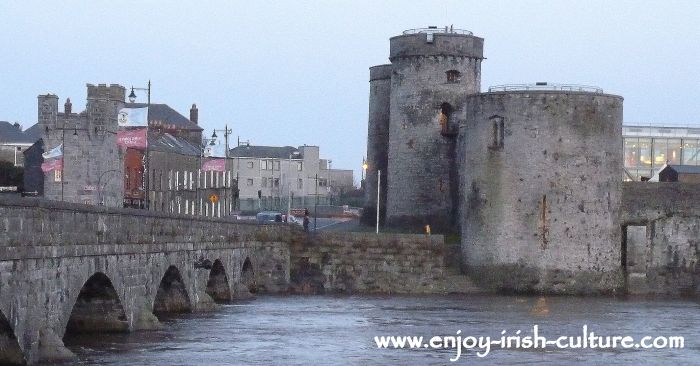About Limerick Castle-
Facts, Features and History
Facts About The Castle
King John (1166-1216) gave orders to build Limerick Castle on his visit to Ireland in 1210, as a Norman stronghold at the fording of the river Shannon.
Preoccupied with conflicts elsewhere, the king died six years later and never got to set foot in the castle himself.
The
Irish castle became known as ‘King John’s Castle’ only hundreds of years
after the kings’ death.
Like
many other castles, King John's Castle, too, was built on the site of a
pre-existing fortification. At Limerick this was a ‘ring work’, which was
a stone and earthwork embankment surrounded by a ditch. The remains of
this earlier fort were discovered by archaeologists during the excavation
of the castle courtyard.
Archaeologists
also discovered the remains of pre-Norman houses and defences from the
Viking era on the site.
- The
adjacent Thomond Bridge replaced a bridge that was built at the same time
as King Johns’ castle.
Features Of King John's Castle
- The
castle was built as a military stronghold and used as a barracks which
determined the overall look and feel.
- Limerick
Castle has no large windows characteristic of a residence which were added
during late medieval times in many other castles, such as Kilkenny
Castle. Instead, there are slits in the walls called arrow
loops which offered excellent cover from which bows or crossbows and
later muskets could be fired.
- The
13th century saw a move away from rectangular towers toward rounded
towers in castles which were considered to offer greater protection
against the siege engines of the time and against the threat of
‘Undermining’. Limerick Castle had four massive barrel towers- some feat
of engineering considering that two of them are located on the rivers’
edge.
- The
‘barrel towers’ were adjoined by four high curtain walls, a large part of
those were adjacent to the river also. The river afforded great protection
from attack.

- The portion of the castle on the river side was
constructed on limestone bedrock which would guarantee excellent protection
against ‘undermining’. Unfortunately for the castle inhabitants of the
seventeenth century the opposite portion was built on clay which lead to their
downfall and the collapse of sections of the wall when besiegers dug tunnels or
‘Gallery mines’ underneath during the 1642 siege.
- Along the curtain walls is a fine wall walk connected
to the corner towers. These were excellent vantage points from which to ‘rain
hell’ with arrows on attackers below.
- Limerick castle as a ‘keepless castle’ (compare Roscommon)
contained no great keep or chamber tower, as many other castles of this period
do, and the soldiers accommodation would more than likely have been constructed
of timber within the courtyard.
The Medieval History Of The Castle
- When the Anglo-Normans invaded and colonised Ireland,
Limerick (and other towns like Dublin or Waterford) had already been settled by
the Viking invaders who were well aware of their strategic importance.
- Limerick occupied a crucial spot because it was situated
on an island at an important fording point on Ireland’s longest river,
the Shannon.
- The Anglo-Normans entered Limerick in 1172 and established a
large garrison there, quickly setting to work on improving fortifications. This
island, ‘Inis Stiobhann’, lay at the confluence of the Abbey river and
the Shannon.
- The island was part of the walled medieval town of Limerick
which developed in the thirteenth century called ’English town’. A neighbouring
walled town known as,‘Irish town’, developed alongside it, and was
occupied by the native Gaelic and Hiberno-Norse (Irish-Viking) population.
- It was the wish of King Henry II that his son, Prince John
would become king of Ireland. He proclaimed him Lord of Ireland in 1177. Henry
II was hoping for a solution to the constant power struggles and
conflicts involving both his Anglo-Norman barons and local Gaelic Chieftains
over control of the island.
- As a young man Prince John visited Ireland, but left
frustrated, failing to consolidate power within the lordship. He returned once
more as an older king in 1210, but events further afield in his vast dominion
were to distract his energies away from Ireland. Limerick castle that bears his
name connects him to Irish history.
- Find out Tourist Information
including our opinion and special tips about King John's Castle here.
If you like what we do please support us in growing our audience- use any one of the social functions provided on this website. Thank you in advance!
Return to the top of this page
Return to 'Irish Castles'
We invest a lot of our own funds and free time into this website so that you can find out about Irish culture, heritage and history.
Please return the favour and help us cover our cost by clicking on Google ads and/ or buying us a cup of coffee! Thank you so much in advance.
Warmest regards, Colm & Susanna
|
|
|
|
Enjoy this page? Please pay it forward. Here's how...
Would you prefer to share this page with others by linking to it?
- Click on the HTML link code below.
- Copy and paste it, adding a note of your own, into your blog, a Web page, forums, a blog comment,
your Facebook account, or anywhere that someone would find this page valuable.
|
|
|
|
- Home
Customs and Traditions
Travel
Music
Heritage
About This Website